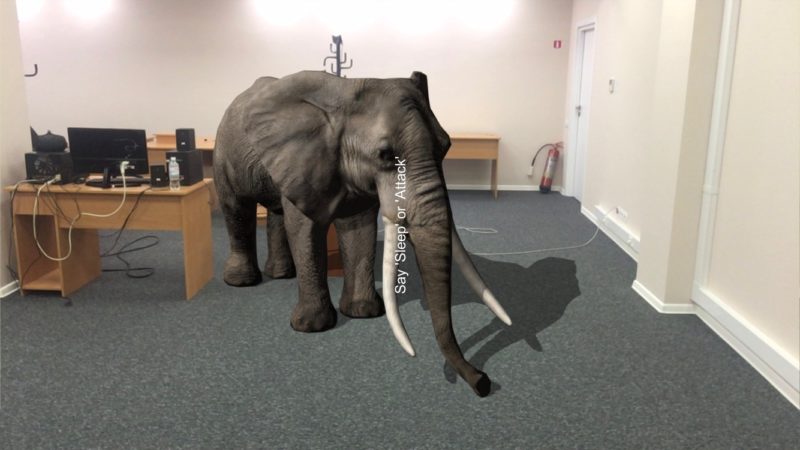With the introduction of ARKit, Apple provided not only a new AR platform, but new AR markets to boot. Boasting the world’s largest AR platform, Apple is relying on developers to make ARKit apps that push the boundaries of what AR can do.
Although there are plenty of examples of ARKit apps online, most only toy with the powerful AR features which the AR development platform offers. Sure, viewing the entire solar system on your kitchen table is neat, but ARKit can do more. Infinitely more.
In a recent article we discussed how to develop cutting edge AR games based on the ARKit feature set. In this article, we will take a similarly non-technical approach to ARKit app development for the lucrative business and industrial AR markets.
A Look At ARKit Features
An AR developer can use ARKit to create AR apps of varying complexity. With relatively little effort, you can, perhaps, create apps that help the user navigate their way through an unfamiliar neighborhood. With a bit more effort, you can develop full-featured applications that solve difficult problems for business or industry. The more complex the problems you solve, the more complex you AR application needs to be, and the greater will be your ROI.
ARKit Capabilities
Making complex apps that satisfy the needs of your target market requires a solid grasp of the capabilities ARKit offers you. Although most of the capabilities and features we will discuss will only benefit users of iPhone X, don’t let that discourage you. There are plenty of new AR features that will run perfectly well on iPhone 6 through iPhone 8 Plus, as well as iPad Pro and iPad Pro (2017).
Here are the three major capabilities offered by ARKit:
- Positional Tracking. ARKit enables apps to detect object position, orientation, and motion within the scene.
- Scene Understanding. This capability is both basic and powerful, allowing apps to detect horizontal planes, to identify stable anchor points, and to adjust the image in accordance with ambient lighting conditions.
- Rendering Integration. ARKit is powerful, but no platform is a one-and-all AR solution. ARKit rendering integration allows development integration with scene-rendering frameworks such as Metal and SceneKit.
The capabilities ARKit provides developers are best demonstrated by utilizing the advanced technologies included in the iPhone X, as explained below.

ARKit demo app by AppReal
How to make ARKit apps.
TrueDepth Camera
The iPhone X TrueDepth cameras empower your apps to have pseudo-3D depth-sensing powers. More specifically, imagine the possible business applications for AR applications with the following features:
- Detection of 50+ muscle movement
- Custom rendering of graphics over 3D face mesh models
- Device position and orientation detection in real time
- Lighting estimation based on the face illumination
- Facial recognition.
Thanks to ARKit, coding these features into your app is the easy part. The challenge is applying them creatively to make unique and powerful AR apps that perform useful work. Consider adding these five functions to your next mobile AR app:
- Face recognition for security apps
- Mood identification for dating apps
- Facial reconstruction tools for the plastic surgery industry
- Scene enhancement for the visually impaired
- 3D scene modeling by drones equipped with Apple devices
We could expand this list a hundred times, but the best ideas for your AR app development business will come from you.
Visual Inertial Odometry
VIO combines sensor and camera data in the mobile device to inform your app of the device’s precise position, orientation, and motion relative to its physical environment. This allows you to equip your app with the following features:
- Precise measurements of objects within the scene
- Detection of object movement within the environment
- Accurate 3D scene-modeling capabilities
- Sensing of acceleration and speed at which the device is moving
How can these features — when combined with AR—be used to create apps for business, industry, and even consumer markets? Here are a five ideas; we are sure you can think of more:
- Autonomous drones that record or transmit AR mapping data
- Conversion of prototype products into precise 3D models by scanning with mobile device
- Performance charting for joggers
- Non-GPS navigation apps for pedestrian tourists
- 3D educational AR apps
To better understand how VIO and AR can work together, check out the videos over on Apple Insider.
High Performance Hardware and Rendering Optimizations
ARKit is designed to fully exploit the power of iOS 11 and Apple’s advanced processors. It is also designed to integrate with other AR development and rendering tools.
Here is a brief list of the advantages ARKit offers, when combined with AR-optimized hardware and 3rd-party technologies such as Metal:
- Extremely low-latency imagery
- Program access to the device Graphics Processing Unit (GPU) for optimized graphics
- Adaptive responses through machine learning
This deceptively short list opens a world of advanced features for the picking, as you develop your next AR app:
- High-speed image rendering for integrating AR data into rapidly moving industrial environments
- Fast and detailed Simultaneous Localization And Mapping (SLAM) functionality
- AR graphics that overlay the environment with life-like realism
- Real-time syncing the app with cloud-based data using a Realm Object Server
- AR apps that don’t wait for the user, but which use machine learning to predict the user’s next action
As powerful as ARKit is, it is, after all, only a development platform. To get the most out of your ARKit apps, you want to target the latest Apple devices. Fortunately, Apple’s online SDK resources make it easy for you to do so.
How AppReal Can Help With Your ARKit Project
Although ARKit is in its infancy, it will be the catalyst by which AR matures into a mainstream technology. To be sure, ARKit will take gaming to the next level, but it would be a mistake not to think of ARKit as more than a game development platform. In truth, the market potential for ARKit applications in business and industry far outshines what we expect to see in the gaming market, as great as that will be.
But market potential is of little value if you don’t have a compelling product. That’s where AppReal comes in. We are a leading provider of outsourced augmented reality development. We are experts in every aspect of VR and AR technologies, and our mobile app developers are among the best in the world. With six R&D labs across Europe, we are positioned to serve your development needs, regardless of your location.
Why not call us, today, for a no-cost consultation?

